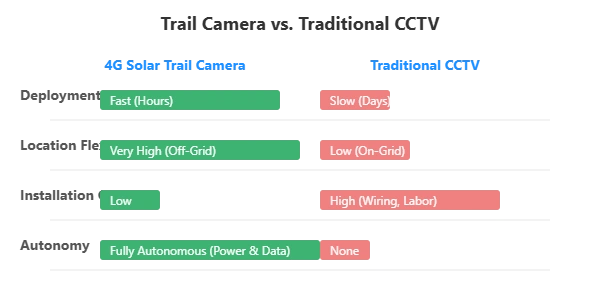Trail Camera Applications: The Ultimate Choice for Remote Mountains, Forest Fire Prevention, and Wildlife Monitoring
Monitoring vast, inaccessible terrains like remote mountains, dense forests, and expansive wildlife habitats presents a fundamental challenge: the absence of power grids and conventional internet infrastructure. For decades, this has been a major roadblock for conservationists, forestry departments, and security professionals. Traditional security solutions are simply not viable. This is the precise pain point where modern 4G solar-powered trail cameras emerge not just as an alternative, but as a superior, purpose-built solution.
As a design and manufacturing factory with 15 years of specialized experience, we’ve engineered solutions that directly address these off-grid challenges. These devices are more than just cameras; they are autonomous surveillance ecosystems designed for resilience and reliability in the harshest environments. For our B2B partners—from 4G operators and brand owners to installers and Amazon sellers—understanding the deep technical advantages of these systems is key to capturing a growing market.
The Core Technology: How 4G Solar Trail Cameras Conquer the Wild
The effectiveness of a trail camera in a remote setting hinges on three pillars of technology: autonomous power, reliable connectivity, and intelligent power management. A failure in any one of these renders the device useless.
1. Uninterrupted Solar Power & Advanced Battery Management: A reliable power source is non-negotiable. Our systems pair high-efficiency monocrystalline solar panels with high-capacity lithium-ion battery packs. But the real intelligence lies in the Battery Management System (BMS). A robust BMS is critical; it’s the brain of the power system, preventing overcharging, over-discharging, short-circuits, and extreme temperature damage. This extends battery life from a few hundred cycles to well over a thousand, a crucial factor for long-term deployments and reducing your clients’ total cost of ownership. For more details, explore the key technology of BMS protection.
2. Seamless 4G LTE Connectivity: Wi-Fi is a non-starter in the wilderness. Our trail cameras are equipped with industrial-grade 4G LTE modules that support multiple frequency bands, ensuring compatibility across different countries and carriers in North America, Europe, and beyond. This allows for real-time video streaming, instant alerts, and remote device management from anywhere in the world. For an installer or a 4G operator, this means offering a true “plug-and-play” solution that works out of the box with a simple data SIM card.
3. Low-Power Consumption & Rapid Wake-Up: To maximize battery life, the camera must remain in a low-power standby mode for most of the time. Our designs utilize highly sensitive Passive Infrared (PIR) sensors that detect motion based on heat signatures. Upon detection, the camera wakes up, records, and transmits data within milliseconds. This efficient cycle ensures the battery can last for weeks or even months without direct sunlight, a critical feature for deployments in areas with variable weather patterns.

Trail Cameras vs. Traditional CCTV: A Clear Distinction
For B2B clients, clearly articulating the value proposition is essential. The difference between a specialized trail camera and a standard security camera is stark. Here’s a breakdown that highlights the commercial advantages for your customers.
| Feature | 4G Solar Trail Camera | Traditional CCTV System |
|---|---|---|
| Power Source | Integrated solar panel & high-capacity battery. Fully autonomous. | Requires connection to a stable 110V/220V power grid. |
| Connectivity | Built-in 4G LTE module. Works anywhere with cellular service. | Requires Wi-Fi or a hardwired Ethernet connection to a router. |
| Installation | Simple, rapid deployment. Mount and activate. No trenching or wiring. | Complex and costly. Requires professional installation, cabling, and power routing. |
| Ideal Environment | Off-grid, remote locations: forests, farms, construction sites, mountains. | Urban and suburban settings with existing infrastructure. |
| Cost of Ownership | Higher initial hardware cost but near-zero operational/installation cost. | Lower hardware cost but high installation and potential infrastructure costs. |
Application Case Studies: Solving Real-World Problems
Theory is one thing; practical application is what convinces customers. Here are two examples demonstrating how our 4G solar trail cameras deliver measurable results.
Case Study 1: Proactive Forest Fire Prevention in a National Park
- Problem: A national park in a remote mountainous region suffered from wildfires. Traditional watchtowers were understaffed and had limited visibility, leading to delayed fire detection, with an average response time of over 3 hours after a fire started.
- Solution: We worked with a local government contractor to deploy 20 of our long-range 4G solar cameras at strategic, high-altitude vantage points. These cameras were equipped with PTZ (Pan-Tilt-Zoom) capabilities and AI-powered smoke detection algorithms.
- Result: Within the first fire season, the system automatically detected 5 potential fire incidents by identifying smoke plumes. Real-time alerts, including GPS coordinates and visual confirmation, were sent to the central command center. The average detection-to-alert time was reduced to under 15 minutes. This enabled rapid deployment of aerial and ground crews, preventing any of the incidents from escalating into major wildfires and saving millions in potential damages.
Case Study 2: Non-Invasive Wildlife Monitoring for Conservation Research
- Problem: A conservation group needed to monitor the population and behavior of an elusive species of mountain cat without disturbing its natural habitat. Physical tracking and manual camera traps were inefficient, requiring bi-weekly trips to retrieve SD cards, which stressed the animals and yielded outdated data.
- Solution: We provided them with camouflaged, low-glow infrared 4G trail cameras. The PIR sensor was tuned for animal signatures to reduce false triggers from foliage. Researchers could access live feeds and receive motion-triggered snapshots directly on their devices from their lab hundreds of miles away.
- Result: The project successfully captured over 2,000 high-resolution images and video clips in the first six months, identifying 12 individual cats and documenting previously unknown feeding behaviors. This reduced human presence in the sensitive habitat by over 90% and provided a continuous stream of data, significantly accelerating their research. This highlights the camera’s use for environmental monitoring and wildlife protection.

Troubleshooting and Best Practices for Deployment
Empowering your clients with knowledge builds trust and reduces support overhead. Here are common questions and expert solutions we’ve developed over years of production and feedback.
- Issue: Inconsistent Charging or Low Battery.
- Solution: Ensure the solar panel faces the direction with maximum daily sun exposure (south in the Northern Hemisphere). Regularly clean the panel surface of dust, pollen, or bird droppings. For forested areas, select a location that avoids being in shadow for most of the day. Finally, verify the BMS is functioning correctly via the remote management app; it provides vital health stats on battery voltage and charging current.
- Issue: Unstable 4G Connection.
- Solution: Before deployment, use a smartphone with the same carrier to check signal strength at the exact installation spot. If the signal is weak (1-2 bars), use one of our models that supports an external high-gain antenna to boost reception. Also, confirm the SIM card is activated, has a sufficient data plan, and is correctly inserted.
- Issue: Too Many False Alerts.
- Solution: This is a common issue solved with proper configuration. Lower the PIR sensitivity to ignore small animals or moving branches. Use the app to define specific motion detection zones, focusing only on the area of interest (e.g., a trail, excluding rustling trees). For advanced needs, our models with AI can differentiate between humans, vehicles, and other movements, virtually eliminating false alarms.
Future Trends: The Evolution of Remote Surveillance
The market for trail cameras is not static. As a B2B partner, staying ahead of the curve is vital for your business. At UBOXCAM, our R&D is focused on what’s next:
- Onboard AI Analytics: Future models will move beyond simple motion detection to performing complex analysis directly on the device. This includes real-time species identification for wildlife research and advanced threat recognition (e.g., distinguishing a person with a tool from a hiker) for security applications.
- Satellite and Mesh Connectivity: For the 10% of the globe with no cellular coverage, we are exploring hybrid models that can leverage satellite uplinks or create local mesh networks to extend range.
- Enhanced Imaging: The demand for higher resolution continues. 4K video and advanced Starlight sensors that provide clear, full-color images in near-total darkness are becoming the new standard. See our breakdown of night vision technologies to understand the difference.
Your Partner in Off-Grid Surveillance Solutions
Whether for forest fire prevention, wildlife monitoring, or securing remote assets like construction sites, 4G solar-powered trail cameras offer a robust, cost-effective, and rapidly deployable solution. They are engineered to solve the specific challenges of operating where traditional systems fail.
As a specialized factory, UBOXCAM provides more than just a product. We offer our B2B partners deep customization capabilities, competitive pricing, and the engineering expertise to create solutions tailored to your market’s needs. Partner with us to equip your clients with the industry’s most reliable and advanced off-grid camera technology. Contact our team today for a consultation and a B2B quote.

